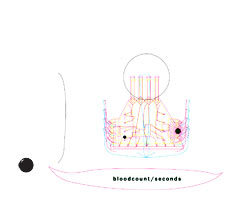Easy to hear why avant sax alchemist Tim Berne persevered in releasing this, though the music was recorded 10-plus years ago: It’s special stuff. He says part of the impetus was the re-formation of Bloodcount -- featuring Berne, drummer Jim Black, windman Chris Speed and bassist Michael Formanek -- for upcoming 2008 giggage. Also, it took him ages to secure the rights to the 1994 Susanna Schönberg documentary vid that accompanies the two CDs. Anyway, “Seconds” can stand tall among the several other scintillatingly LIVE documents of the most unusual unit that is Bloodcount.
Berne says he prefers to go for a band sound, and these adepts, together for several years, developed amazing instincts for interaction out of their extremely distinctive individual skills. Somehow, through excursions often in the 20-minute range that require radical changes of theme and intensity, they never get in one another’s way, knocking around like four shooters on a full basketball court. While the compositions assign limits within which each dude ranges, the feel is anything but tyrannical.
“You'd be surprised how much is improvised,” Berne explains. “The written music is there to provoke/promote improvisation. Since I like to be surprised by my own music, I give the players a pretty big stake in the results. I try to write with the improvising going through my head at the same time.”
Black owns the rare ability to act as a full-spectrum colorist without leaning much on the cymbals; he can also be a whambang rhythmic driver. Formanek, a big and lowdown bassist, lends both a sense of perpetual motion and a deeply cushioning rubber mat you just can’t fall off. Speed, the melodic foil on clarinet and tenor, applies uncanny intuition; even when he lands on a note a half step away from Berne, it sounds like a harmony. On occasional chamber-like passages, the four really breathe as one. All this lavishes freedom and inspiration on Berne, whose alto slaloms through the obstacle course with giddy abandon; as author, he gets to realize his own dream and stick the listener inside it.
The two considerably different takes on “Yes, Dear” emphasize funky hipshake in one version, and boppy Latin melting into Aylerish freedom in the other. “Screwgun” takes the group’s usual obsessive counterpoint in a heavy, bluesy direction. The cooperative battling of “Mr. Johnson” turns on an attractively off-balance rhythm like a bicycle tire with a bubble in it. (These wand-wavers do scary things with time.) But any description could only come off like a momentary snapshot of a continuously unspooling journey. Really hearing this music is a matter of immersion, and you won’t want to be distracted by flashbulbs or cocktail chatter.
Which is why the nearly hourlong documentary disc was perhaps not worth waiting for. While Ms. Schönberg succeeds in dodging the clichés of static performance footage, she either misses the point of what it means to experience the stretched development of “Eye Contact,” or she deliberately subverts it. At random intervals, she cuts away from her many bleached closeups of the artists and their instruments (although flowing GROUP interplay is the whole idea) to tinted scenes of the guys traipsing around Paris sans music. Painful. Still, it’s good to see the faces. Speed and Black look so damn young in ‘94.
Berne continues today, with his Paraphrase and Science Friction groups, to explore the long forms he essayed with Bloodcount and before -- to his financial discredit, of course. But if you don’t think you have time to take in a really exciting 25-minute group comprovisation, it may not mean Berne is screwing up. It may mean you need a vacation.

